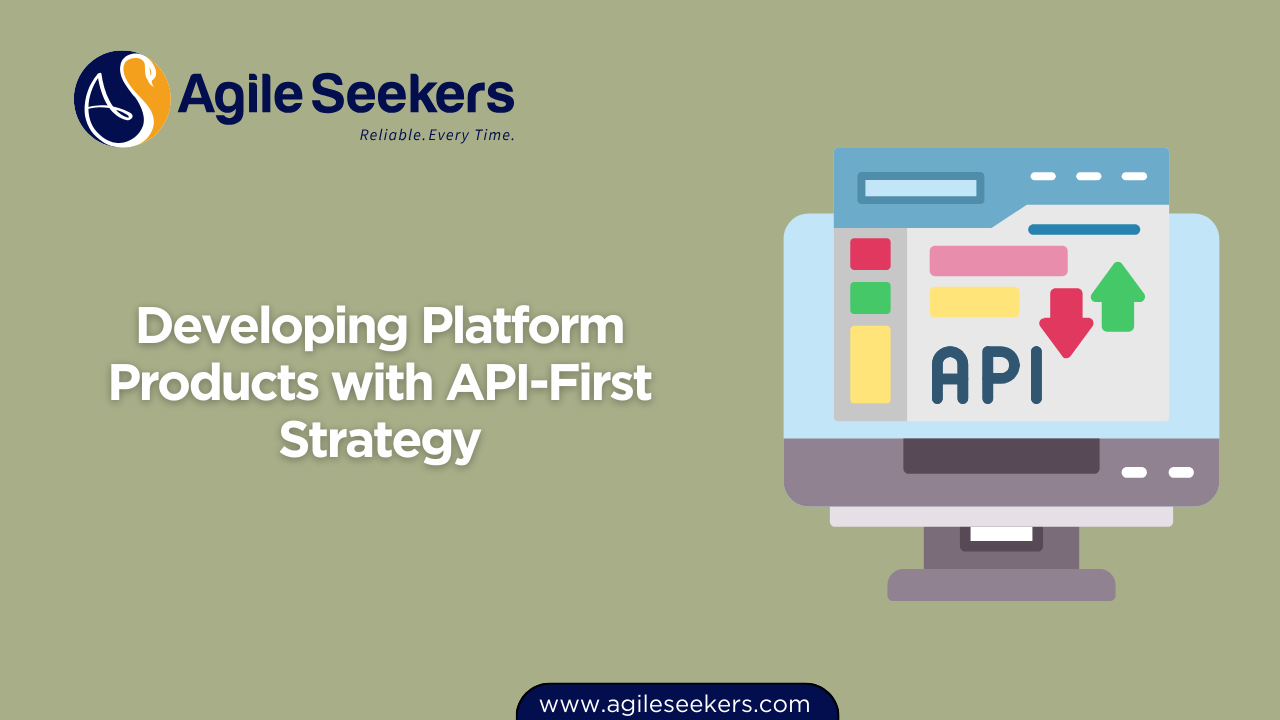Developing Platform Products with API-First Strategy

Platform products have redefined how companies deliver value at scale. Whether it's an e-commerce engine, a developer toolset, or a digital payments layer, modern platforms are expected to integrate, evolve, and serve multiple audiences. An API-first approach ensures that these platforms remain modular, scalable, and future-ready.
Let’s unpack what API-first truly means, why it matters in platform product development, and how to apply it from discovery to post-release iteration.
What is an API-First Strategy?
An API-first approach treats APIs as primary citizens in product development. Rather than bolting APIs on after the product is built, teams define and design APIs before writing any business logic or user interface code. This ensures consistency across services and accelerates delivery across platforms—web, mobile, partner systems, and more.
Adopting this strategy benefits product managers, engineers, designers, and stakeholders by creating a shared contract before execution begins.
Why API-First Matters in Platform Products
- Scalability: API-first platforms are easier to scale horizontally. You can expose functionality independently and let internal teams or external partners consume services without dependencies on a single UI or stack.
- Reusability: APIs serve multiple consumers. A well-documented API might support a mobile app, a customer dashboard, a partner integration, and internal analytics—without rewriting logic.
- Speed of Delivery: Teams can work in parallel. Frontend developers can use mocked endpoints, while backend teams finalize logic and infrastructure.
- Better Testing and Automation: APIs make it easier to write automated tests, support CI/CD, and handle load testing at an early stage.
Start with Clear Domain Modeling
Before jumping into REST or GraphQL decisions, clarify your domain. What are the core resources, entities, and relationships? This step is crucial and often where platform products fail. A well-thought-out domain model reduces future complexity and allows your API surface to remain clean and intuitive.
Product managers with SAFe POPM Certification are often better equipped to handle this alignment, as they’re trained in value stream thinking and lean prioritization across multiple system layers.
Design APIs Before Code
Use API specification tools like OpenAPI (Swagger), API Blueprint, or Postman to define your endpoints. These specs serve as contracts between teams and reduce ambiguity.
Include:
- Endpoint structure
- Request/response formats
- Status codes and error messages
- Rate limits and security considerations
Teams that practice API mocking early can catch integration gaps before writing backend logic, reducing rework in later stages.
Versioning and Backward Compatibility
As platforms grow, your API must evolve. But changes shouldn't break existing consumers. Adopt versioning strategies like URI versioning (e.g., /v1/products) or header-based versioning. Use semantic versioning to communicate the impact of changes clearly.
Version control isn’t just a technical necessity; it’s a product responsibility. Platform PMs must balance internal roadmap needs with external commitments.
Authentication and Security
Security is integral to platform trust. OAuth 2.0, API keys, and JWTs are common strategies depending on the use case. Rate limiting, IP whitelisting, and scope-based access are essential safeguards for public APIs.
If you’re managing third-party integrations, prioritize API gateway usage (like Kong, Apigee, or AWS API Gateway) for traffic monitoring, analytics, and abuse prevention.
Refer to the OWASP API Security Top 10 to align with best practices in preventing API-specific vulnerabilities.
Documentation and Developer Experience (DX)
APIs are products. Your developer documentation should be treated as a core deliverable. Tools like Swagger UI, Redoc, and Stoplight can generate interactive documentation that speeds up developer onboarding.
Consider investing in a developer portal with examples, SDKs, and support channels. Well-designed APIs often go unused if developers don’t understand how to access them quickly.
Monitoring and Analytics
Once live, APIs need to be monitored like any other user-facing feature. Track:
- Usage metrics per endpoint
- Error rates and latencies
- Third-party consumers
Analytics tools like Datadog, New Relic, and Prometheus can help you maintain uptime and performance. These insights inform product decisions around deprecation, optimization, or feature expansion.
CI/CD Integration for API Deployments
Automate testing and deployment with CI/CD pipelines. Use tools like Jenkins, GitHub Actions, or GitLab CI to automate API test suites, security scans, and deployments. Containerize microservices (using Docker) and orchestrate them via Kubernetes or ECS for scalable release pipelines.
If you're pursuing PMP Certification, you’ll appreciate how structured release planning, risk mitigation, and stakeholder communication play a role even in technical initiatives like these.
Driving Business Value Through APIs
APIs enable monetization, partnerships, and customer retention. Stripe, Twilio, and Shopify are examples of businesses built on the strength of their API platforms. Product managers must work with marketing, sales, and legal teams to shape API usage policies, rate plans, and partner onboarding flows.
APIs also help you experiment faster—whether it’s A/B testing a new recommendation engine or exposing beta features to a few partners.
Aligning API Strategy with Product Roadmap
Platform PMs need a dual mindset: maintain stable foundations while enabling future innovation. Plan APIs to support extensibility. Don’t tie endpoints too tightly to current UI elements—design around resources, not screens.
For cross-functional collaboration, applying SAFE Product Owner Certification practices can help create shared understanding and alignment across Agile teams, architects, and system stakeholders.
Conclusion
Building a successful platform product with an API-first approach requires more than just technical skill—it demands strong product thinking, stakeholder alignment, and a commitment to developer experience. When done right, APIs become a growth engine that accelerates integration, innovation, and scalability across your ecosystem.
If you're a product manager working on platform strategies, upskilling through PMP training or SAFe POPM training will provide the structure and frameworks needed to lead such initiatives effectively.
Also read - Managing Product Releases with GitOps and CI/CD Awareness
Also see - Applying Jobs-to-be-Done (JTBD) Framework to Tech Product Discovery




















